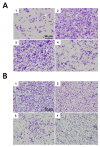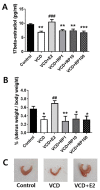Effects of Radix Polygalae on Cognitive Decline and Depression in Estradiol Depletion Mouse Model of Menopause
- PMID: 34698102
- PMCID: PMC8929121
- DOI: 10.3390/cimb43030118
Effects of Radix Polygalae on Cognitive Decline and Depression in Estradiol Depletion Mouse Model of Menopause
Abstract
Postmenopausal syndrome refers to symptoms caused by the gradual decrease in female hormones after mid-40 years. As a target organ of estrogen, decrease in estrogen causes various changes in brain function such as a decrease in choline acetyltransferase and brain-derived neurotrophic factor; thus, postmenopausal women experience cognitive decline and more depressive symptoms than age-matched men. Radix Polygalae has been used for memory boosting and as a mood stabilizer and its components have shown neuroprotective, antidepressant, and stress relief properties. In a mouse model of estrogen depletion induced by 4-vinylcyclohexene diepoxide, Radix Polygalae was orally administered for 3 weeks. In these animals, cognitive and depression-related behaviors and molecular changes related to these behaviors were measured in the prefrontal cortex and hippocampus. Radix Polygalae improved working memory and contextual memory and despair-related behaviors in 4-vinylcyclohexene diepoxide-treated mice without increasing serum estradiol levels in this model. In relation to these behaviors, choline acetyltransferase and brain-derived neurotrophic factor in the prefrontal cortex and hippocampus and bcl-2-associated athanogene expression increased in the hippocampus. These results implicate the possible benefit of Radix Polygalae in use as a supplement of estrogen to prevent conditions such as postmenopausal depression and cognitive decline.
Keywords: VCD; cognition; depression; estrogen; radix polygalae.
Conflict of interest statement
The authors declare no conflict of interest.
Figures







Similar articles
-
Preclinical evidence of rapid-onset antidepressant-like effect in Radix Polygalae extract.PLoS One. 2014 Feb 10;9(2):e88617. doi: 10.1371/journal.pone.0088617. eCollection 2014. PLoS One. 2014. PMID: 24520403 Free PMC article.
-
Radix Polygalae extract exerts antidepressant effects in behavioral despair mice and chronic restraint stress-induced rats probably by promoting autophagy and inhibiting neuroinflammation.J Ethnopharmacol. 2021 Jan 30;265:113317. doi: 10.1016/j.jep.2020.113317. Epub 2020 Aug 28. J Ethnopharmacol. 2021. PMID: 32861821
-
Kai-Xin-San series formulae alleviate depressive-like behaviors on chronic mild stressed mice via regulating neurotrophic factor system on hippocampus.Sci Rep. 2017 May 3;7(1):1467. doi: 10.1038/s41598-017-01561-2. Sci Rep. 2017. PMID: 28469194 Free PMC article.
-
Polygalae Radix: A review of its traditional uses, phytochemistry, pharmacology, toxicology, and pharmacokinetics.Fitoterapia. 2020 Nov;147:104759. doi: 10.1016/j.fitote.2020.104759. Epub 2020 Oct 15. Fitoterapia. 2020. PMID: 33069838 Review.
-
Role of estrogen replacement therapy in memory enhancement and the prevention of neuronal loss associated with Alzheimer's disease.Am J Med. 1997 Sep 22;103(3A):19S-25S. doi: 10.1016/s0002-9343(97)00260-x. Am J Med. 1997. PMID: 9344403 Review.
Cited by
-
A review of the botany, metabolites, pharmacology, toxicity, industrial applications, and processing of Polygalae Radix: the "key medicine for nourishing life".Front Pharmacol. 2024 Sep 18;15:1450733. doi: 10.3389/fphar.2024.1450733. eCollection 2024. Front Pharmacol. 2024. PMID: 39359244 Free PMC article. Review.
-
Saponin components in Polygala tenuifolia as potential candidate drugs for treating dementia.Front Pharmacol. 2024 Jul 10;15:1431894. doi: 10.3389/fphar.2024.1431894. eCollection 2024. Front Pharmacol. 2024. PMID: 39050746 Free PMC article. Review.
-
Coconut Oil Saturated Fatty Acids Improved Energy Homeostasis but not Blood Pressure or Cognition in VCD-Treated Female Mice.Endocrinology. 2023 Jan 9;164(3):bqad001. doi: 10.1210/endocr/bqad001. Endocrinology. 2023. PMID: 36626144 Free PMC article.
-
Bidirectional association between depression and cognition in Chinese middle-aged and older women: a 10-year longitudinal study.Front Psychiatry. 2025 May 2;16:1531202. doi: 10.3389/fpsyt.2025.1531202. eCollection 2025. Front Psychiatry. 2025. PMID: 40386116 Free PMC article.
-
Polygalae Radix: review of metabolites, pharmacological activities and toxicology.Front Pharmacol. 2024 May 30;15:1420853. doi: 10.3389/fphar.2024.1420853. eCollection 2024. Front Pharmacol. 2024. PMID: 38873413 Free PMC article. Review.
References
MeSH terms
Substances
Grants and funding
LinkOut - more resources
Full Text Sources
Medical
Research Materials

